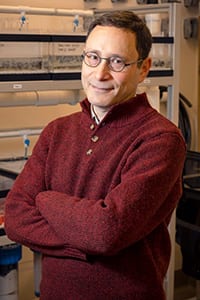
Investigator, Burnell R. Roberts Chair in Regenerative Biology
Area:
Phone:
(608) 316-4105
Email:
[javascript protected email address]
Research website >Research in my laboratory seeks to understand why some animals can regenerate missing or damaged organs. To this end we study flatworms known as planarians that can regenerate entire new animals from tiny fragments of the body; this amazing ability relies on stem cells that the animal maintains throughout life. By studying the planarian we hope to understand how stem cells are regulated to produce missing tissues and organs in the context of a whole organism. Insights gained from our basic research on planarian biology have also led us to study parasitic flatworms, like schistosomes and tapeworms. As we learn more about how schistosomes infect their hosts and reproduce inside them, we hope to devise new strategies for controlling these devastating parasites that infect hundreds of millions of people in the developing world.
Education
BA, Biology, Boston University
PhD, Molecular, Cellular, and Developmental Biology, University of Colorado at Boulder
Honors
Investigator, Howard Hughes Medical Institute
CAREER Award, National Science Foundation
Damon Runyon Scholar, Damon Runyon Cancer Research Foundation
University Scholar, University of Illinois at Urbana-Champaign
American Association for Advancement of Science, Fellow
Selected Publications
- Issigonis, M., Redkar, A.B., Rozario, T., Khan, U.W., Mejia-Sanchez, R., Lapan, S.W., Reddien, P.W., and P.A. Newmark. 2022. A Krüppel-like factor is required for development and regeneration of germline and yolk cells from somatic stem cells in planarians. PLOS Biology 20: e3001472.
- Khan, U.W., and P.A. Newmark. 2022. Somatic regulation of female germ cell regeneration and development in planarians. Cell Reports 38: 110525.
- Lee, J., Chong, T., and P.A. Newmark. 2020. The esophageal gland mediates host immune evasion by the human parasite Schistosoma mansoni. Proc. Natl. Acad. Sci. 117: 19299-19309.
- Rozario, T., Quinn, E.B., Wang, J., Davis, R.E., and P.A. Newmark. 2019. Region-specific regulation of stem cell-driven regeneration in tapeworms. eLife 8: e48958
- Gao, J., Yang, N., Lewis, F.A., Yau, P., Collins III, J.J., Sweedler, J.V., and P.A. Newmark. 2019. A rotifer-derived paralytic compound prevents transmission of schistosomiasis to a mammalian host. PLOS Biology 17(10): e3000485.
- Wang, B., Lee, J., Li, P., Saberi, A., Yang, H., Liu, C., Zhao, M., and P.A. Newmark. 2018. Stem cell heterogeneity drives the parasitic life cycle of Schistosoma mansoni. eLife 7: e35449.
- Saberi, A., Jamal, A., Beets, I., Schoofs, L., and P.A. Newmark. 2016. GPCRs direct germline development and somatic gonad function in planarians. PLOS Biology 14: e1002457 (cover).
- Wang, B., Collins III, J.J., and P. A. Newmark. 2013. Functional genomic characterization of neoblast-like stem cells in larval Schistosoma mansoni. eLife 2:e00768.
- Sikes, J.M. and P. A. Newmark. 2013. Restoration of regeneration in a planarian with limited regenerative ability. Nature 500: 77-80.
- Collins III, J.J., Wang, B., Lambrus, B.G., Tharp, M., Iyer, H., and P. A. Newmark. 2013. Adult somatic stem cells in the human parasite, Schistosoma mansoni. Nature 494: 476-479.